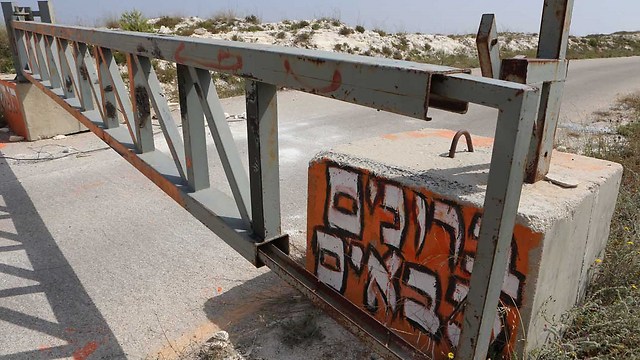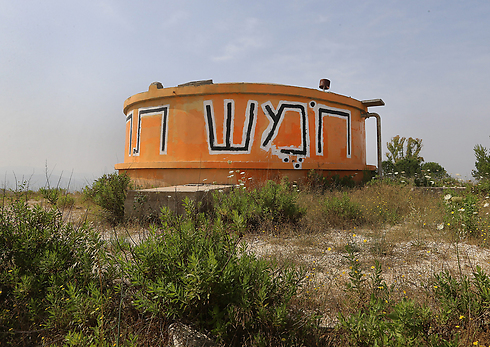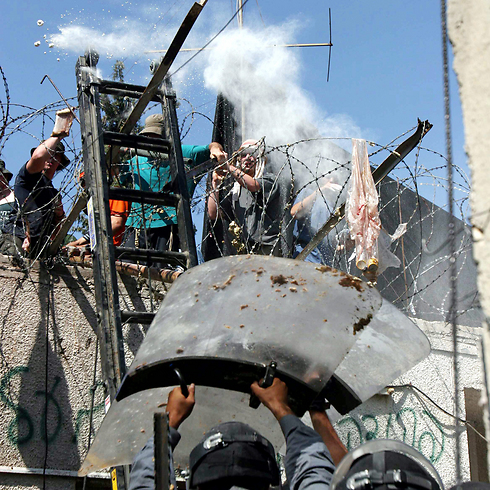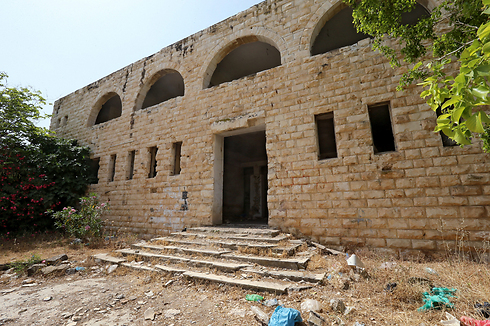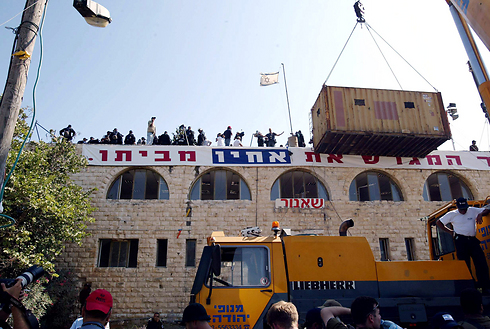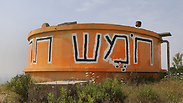
A narrow side road covered with dirt and gravel leads to the top of the mountain upon which the settlement of Homesh once stood. The road there is unmarked and it's easy to miss the turn from the main road.
After a few hundred meters, the first signs of what happened here a decade ago come into view - long orange ribbons are still tied to rocks on the side of the road, and a black scorch mark on the asphalt is evidence to a tire that was set ablaze there.
At the entrance to the former settlement we are met with a heavy iron gate standing on two concrete blocks with the writing "Welcome to - Homesh" in Hebrew on the one side, and "Fatah, Hamas, Popular Front" in Arabic on the other side.
We open the unlocked gate and continue up the mountain. Additional turns onto the abandoned roads show more concrete blocks with the Arabic writing "Security - Force 17," Fatah's elite unit which later turned into the Palestinian Authority's presidential guard.
Wild vegetation is already covering the spots where Homesh's houses once were, in between piles of rocks, the remains of the wrecked houses. Only sidewalks with the curb painted red and white and two lonely electric poles indicate that there were once people here.
Silence mixed with a sense of unease overwhelms us during our slow drive.
At the top of the mountain, the settlement's mythological water tower still stands and the view in front of us is spectacular. The giant writing "Homesh First!" and the sign of the Menorah is still there, but a closer look finds Arabic and English graffiti praising the Popular Front for the Liberation of Palestine, Allah and Jerusalem. On the other side of the tower, someone wrote "Palestine - we love you" in English, which someone else covered with paint.
All of a sudden, four Jewish teens appear, wearing large kippahs (skullcaps) and prayer shawls. They approach us with a look of suspicion and apprehension, covering their faces to avoid being identified.
"Who are you?" they call out. "There is nothing for you here."
When they realize we are journalists, they break into a run down the mountain and disappear into a thicket of bushes and trees without stopping to talk to us and explain why they were there and what they were guarding.
We slowly walk down the mountain and move on to the nearby Sa-Nur, which looks better than what's left of Homesh. A short road, at the end of which there's an abandoned Palestinian gas stop, leads to the settlement.
Sa-Nur's main structure - originally a police stronghold from the time of the British mandate - is still standing, surrounded by trees and bushes.
A decade after the evacuation of the settlement, the structure is abandoned and neglected. Some of his many rooms have since been turned into sheep pens, but now the building stands empty and deserted.
On top of the pungent smell of urine and feces, we notice a Hebrew-Arabic graffiti war on the structure's walls: "Death to Arabs" alongside "the Izz ad-Din al-Qassam Brigades," "Homesh Youth, Respect!" while the symbol of the Kahane Chai (Kahane is Alive) movement is alongside the writing "al-Quds" (Jerusalem). Someone also expressed their taste in music, writing "Zohar (Argov) Rules."
Under all of the graffiti, one can still see the original decorations on the walls from the days people still lived in the settlement.
Outside the structure we meet Nadam Halilia, a resident of Nablus, who said he came to the former settlement to get a breath of fresh air, enjoy the view, and relax.
"Once every two weeks, settlers come here. They go into the buildings and make noise. Occasionally, there are clashes and yelling with the Palestinians, but it doesn't get out of control," he says, complaining that the Palestinians cannot live in either of the former settlements, even though Israel evacuated them.
"Look at Homesh," he points south. "What a great view you can see from there."















